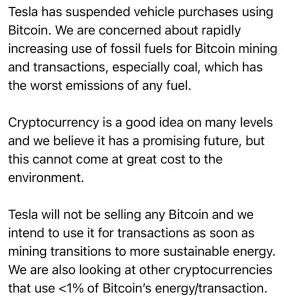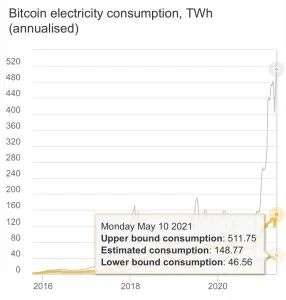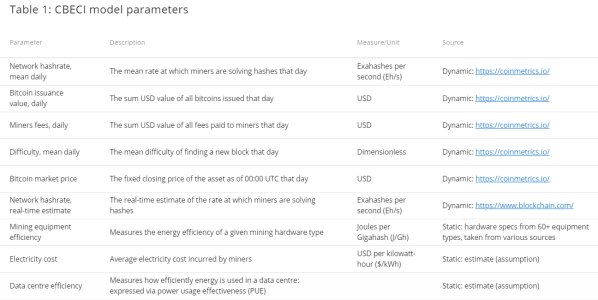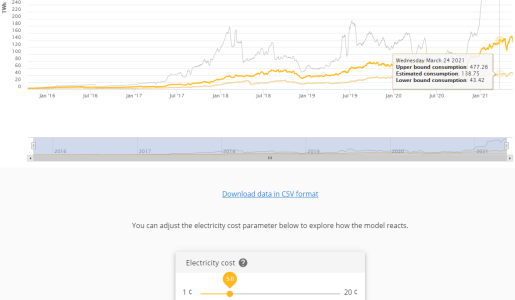Musk, who dared to go to Mars, was afraid of Bitcoin.
Editor’s note: This article is from the WeChat public account “Che Dongxi” (ID: chedongxi).
Author|克克
Edit|Xiaohan
Musk recently played a show operation again.
A few days ago, he announced that Tesla would stop accepting Bitcoin payments because the energy consumption of “Bitcoin mining and trading” is too high, which does not conform to Tesla’s “green environmental protection” corporate culture.
As soon as this remark came out, the people who ate melons couldn’t stand it anymore, and they asked, the electricity used to build and drive electric cars also comes from fossil energy. Why do you use it for environmental protection, and others use it as pollution?
The rhetoric of the people who eat melons is not unreasonable, but if you want to see this through, you need to answer the following three key questions:
1. How much electricity does it cost to mine Bitcoin? Is it time to suspend Bitcoin payments?
2. Where did Musk’s energy consumption data come from, and how did he calculate it?
3. When Musk announced that Bitcoin could be used for payment, was it a period when Bitcoin mining energy consumption was low?
Che Dongxi found the answer to the above question after carefully studying the evidence cited by Musk-the relevant research results of the Cambridge University Alternative Finance Center.
The benefits of this article; Tesla once purchased $1.5 billion in Bitcoin, and Bitcoin has accelerated its entry into the mainstream asset allocation vision in the United States, sharing the report “Tesla bought Bitcoin, digital gold “out of the circle””, public account The dialog box responds to [car stuff 0205] download.
01. Bitcoin mining for one year consumes enough electricity for Argentina to use for one year
Musk posted a tweet on May 13 this year. He stated that Tesla will suspend support for Bitcoin payments because they are concerned about the rapid increase in fossil fuel consumption during Bitcoin mining and transactions. Especially in the use of coal, coal has the largest amount of greenhouse gas/pollutant emissions after combustion of all fuels.
Although cryptocurrency has certain advantages from many aspects, Tesla also admits that the market prospect of cryptocurrency is bright, but it cannot be at the expense of the environment. In addition, Tesla will not sell Bitcoin anymore, unless people can find a more energy-efficient and environmentally friendly way to mine and trade Bitcoin. Simultaneously,Tesla is also exploring other forms of cryptocurrency that consume less than 1% of Bitcoin.
▲Musk’s original Twitter on May 13
Musk said that the high energy consumption of the Bitcoin industry is not groundless. His theoretical basis comes from the Bitcoin Electricity Consumption Index (CBECI) model provided by the Cambridge University Alternative Finance Center. The data provided by the model shows that if the global “miners” continue to mine for a whole year at the power consumption level of May 10, 2021, the total power consumption is expected to be 148.77 MWh.
▲Screenshot of the form provided by Musk, data from the University of Cambridge Alternative Finance Center
So what is the concept of 148.77 MWh?
According to the statistics of the National Energy Administration, China’s total electricity consumption in 2020 is 7,511 MWh, of which the primary industry’s electricity consumption is 85.9 MWh, which means that the electricity consumed by Bitcoin mining and trading is sufficient my country’s primary industry needs and has a surplus.
In addition, according to Enerdata statistics, Malaysia’s annual power consumption in 2019 was 155 MWh, and Argentina’s annual power consumption was only 125 MWh. In other words, the electricity consumed by global bitcoin mining and trading activities is enough to support some countries for one year.
If you look at the power consumption of the Bitcoin industry in this way, people would probably not be surprised that Musk stopped buying cars with Bitcoin.
02. Cambridge University uses data models to estimate power consumption. The algorithm has limitations
Some people may be curious, how does the Cambridge University Alternative Finance Center obtain these data?In the screenshot given by Musk, how are the upper bound consumption and lower bound consumption defined? There are several unremarkable curves in the chart. What do these curves mean?
The official website of the University of Cambridge has given the answer.
Actually, the Cambridge (University) Bitcoin Power Consumption Index (CBECI) is a mathematical model that estimates the power consumption of the Bitcoin industry in real time. This mathematical model will take into account the influence of many factors on the power consumption of the industry, among which data such as computing power (hash rate), Bitcoin insurance turnover on the day, and Bitcoin market price are provided by fixed information sources, but electricity costs and data center efficiency Such data can only rely on estimates.
▲Cambridge (University) Bitcoin Power Consumption Index (CBECI) needs to use variables
In order to avoid partial generalization, Cambridge University designed a relatively rational and conservative algorithm for this model, so that it can output a relatively wide range of data, rather than a data point that cannot be falsified.
Assuming that all “miners” use the most energy-efficient tools on the market, and the power consumption of the equipment site is only 1% higher than that required for normal operation, the entire industry has the lowest power consumption at this time, this lowest power consumption The quantity is the lower bound consumption (Lower bound consumption).
Correspondingly, assuming that all “miners” use the most power-consuming tools on the market (unless it costs too much power to lose money), and the power consumption of the equipment site is 20% higher than that required for normal operation. At this time, the entire industry The highest power consumption is the upper bound consumption.
It can be seen that part of the estimated value range of power consumption between the upper and lower limits, and the upper and lower curves represent the trend of the upper and lower limits of power consumption over time.
So how did the University of Cambridge find the data points that they think are the closest to reality from the range of values?
They collected the technical specifications of more than 60 types of mining equipment, and designed a set of equipment selection logic based on the specification data. This set of logic can guide people to find the equipment with the highest probability of maximizing profits. They believe that the device matching method found by following this set of logic should be sufficient to represent most of the other “The equipment matching method used by miners.
In order to verify the accuracy of this logic, the design team found a paper published by others in 2019. This paper provides the market share of different mining equipment in the past few years. Based on market share data, they calculated the total power consumption of the Bitcoin industry from January 2015 to June 2019.
This total power consumption data will inevitably have a certain error, the error is not even small, but it is an established fact and cannot be changed at will.
Subsequently, the design team gave the optimal solution for the equipment configuration based on the logic, combined with the premise that the power consumption of the equipment is only 10% higher than that required for normal operation, and concluded that they can give the best solution. The total power consumption of the Bitcoin industry during the exact same period.
By comparing and verifying the two power consumption values, people found that the difference between the two is not too big.
The University of Cambridge believes that unless they can learn more specific tool market share data or develop better algorithms, what they currently give is the closest estimate to the actual value within their ability.
From beginning to end, the University of Cambridge has not stated that the data given by the Cambridge (University) Bitcoin Power Consumption Index (CBECI) can be used as an authoritative basis. In fact, they have been emphasizing that this mathematical model has certain limitations.
First of all, there are many influencing factors that are not considered by this mathematical model. For example, different institutions will choose different mining tools. The actual work efficiency of mining tools may not match the manufacturer’s description. Factors such as labor costs will trigger the total cost. Increase and so on, and these factors may not be uncommon in reality.
Even if all interference factors are ignored, the cost of electricity is probably inevitable. What Musk didn’t tell everyone was that the data he got was only on the premise that the electricity bill was constant at 5 cents per kilowatt hour (the CBECI default electricity bill).
The University of Cambridge believes that electricity bills have a great impact on the Bitcoin industry. If electricity bills are too high and mining becomes unprofitable, people will naturally give up mining and the industry’s power consumption will drop sharply. The Cambridge Business School website intimately provides options for adjusting electricity bills, giving people the opportunity to intuitively feel what the annual electricity consumption of the Bitcoin industry will look like when the electricity bill is 1 cent or 20 cents per kilowatt-hour.
The data given by Musk was obtained on Monday, May 10, 2021. At this time, CBECI estimates that the annual electricity consumption of the Bitcoin industry is 148.77 MWh under the premise that the electricity bill is 5 cents per kWh. If it is the same day and the electricity bill is adjusted to 1 cent or 20 cents per kilowatt hour, the annual power consumption of the Bitcoin industry will become 170.95 MWh or 88.51 MWh.
Musk did not explain why he used the data provided by CBECI under the default setting of 5 cents per kilowatt-hour, nor did he explain why he did not use the data under other electricity tariff settings as a rationale.On the basis.
Compared with the data of the default electricity bill, the data given by CBECI after adjusting the electricity bill has not changed much. This phenomenon also illustrates the fact from the side that the industry power consumption data provided by CBECI is not the true value, because the true value is determined, and if it is set, it is set. Even if the existence of error cannot be avoided, even if the error is still large, the true value will at least not “change with you”.
What’s more, electricity bills around the world are not the same, and they are not all settled in U.S. dollars, and they won’t even stay the same for a long time. Based on only a constant electricity bill level, combined with a limited algorithm, the estimated annual power consumption of the industry may not be very universal, and it is difficult to fully reflect the reality.
03.No major fluctuations in power consumption. Stopping Bitcoin payment is a Sao operation
Aside from the limitations of the data itself, Musk’s own argumentation process may not be rigorous enough.
Musk’s original tweet stated that Tesla’s suspension of Bitcoin payments was due to the sudden increase in fossil energy consumption for Bitcoin mining and transactions.
▲Musk originally tweeted that they were worried about the rapid increase in fossil energy consumption caused by the development of the Bitcoin industry
However, the University of Cambridge only provided an estimate of the annual electricity consumption of the Bitcoin industry. It did not mention the source of electricity or fossil energy consumption in the Bitcoin industry, let alone the greenhouse gases or pollutants caused by power generation. emission.
Musk’s promotion of the Bitcoin industry’s annual electricity consumption provided by the University of Cambridge as equivalent to fossil energy consumption or greenhouse gas/pollutant emissions is biased.
What’s more, with the rise of human environmental awareness in recent years, many countries, institutions and individuals have invested in the clean energy industry and achieved certain results. Even if the Bitcoin industry consumes more electricity, it does not necessarily mean that the power generation industry emits high greenhouse gases or pollutants.
China has long embarked on the road of national energy structure transformation. According to the “China Energy Big Data Report (2020)” provided by the National Energy Administration, in 2019, the country’s power generation was about 7,503 MWh, of which hydropower accounted for about 1,304 MWh, a year-on-year increase of 5.9%;Nuclear power accounted for approximately 348 MWh, an increase of 18.3% year-on-year; wind power accounted for approximately 406 MWh, an increase of 10.9% year-on-year; photovoltaic power accounted for approximately 224 MWh, an increase of 26.3% year-on-year; biomass power generation was 111 MWh, a year-on-year increase An increase of 20.4%.
If all the electricity consumed by the Bitcoin industry comes from clean energy, in fact, the industry’s greenhouse gas or pollutant emissions may remain the same or even decrease instead of rising.
Unfortunately, Musk did not provide any evidence to support his conclusion that the consumption of fossil energy in the Bitcoin industry is increasing rapidly. After all, who can figure out where every kilowatt of electricity comes from?
So how much impact will Tesla’s suspension of Bitcoin delivery have on the world’s environmental protection cause?
Musk first mentioned that Tesla will support Bitcoin delivery on March 24, 2021, but only car owners in the United States can choose Bitcoin to pay.
▲Musk tweeted on March 24 that Tesla supports Bitcoin delivery.
▲The vehicle customization page of Tesla’s US official website, the lower right shows support for Bitcoin payment
In order to ensure a fair comparison, all the following data are based on the rules adopted by Musk, and the rules are as follows:
1. The data provided by the Cambridge (University) Bitcoin Power Consumption Index (CBECI) is the only data that can fully reflect reality.
2. The electricity bill around the world is 5 cents per kilowatt hour, and it will never change.
3. The annual electricity consumption of the Bitcoin industry is equivalent to the industry’s greenhouse gas/pollutant emissions.
So what is the annual power consumption of the Bitcoin industry based on the power consumption rate of the Bitcoin industry on March 24?
Only over a month later, May 13, Musk announced the suspension of Bitcoin payments. In this process, how much has the annual electricity consumption of the Bitcoin industry increased?
▲CBECI shows the estimated annual power consumption of the Bitcoin industry on March 24 (the default electricity cost is 5 per kilowatt Cents)
As can be seen from the picture, when Musk announced that Tesla started accepting Bitcoin payments on March 24, CBECI estimated the annual power consumption of the Bitcoin industry to be about 138.75 MWh based on the data on that day. When Musk announced that Tesla would stop Bitcoin payments on May 13, CBECI calculated the estimated annual power consumption of the Bitcoin industry at 148.77 MWh based on the data on May 10. Comparing the two data, the latter has an increase of 10.02 MWh over the former, an increase of about 7.2%.
It is worth noting that the graph curve shows that the data given by the website does not increase all the time. From March 24 to May 10, 2021, the trough of the estimated annual electricity consumption of the Bitcoin industry appeared on April 22. CBECI calculated based on the data of the day that the annual electricity consumption of the Bitcoin industry was about 110.18. MWh, compared with 138.75 MWh on March 24, there is a decrease of 28.57 MWh, a decrease of about 20.6%.
In fact, according to the chart given by CBECI, the most recent surge in annual power consumption in the Bitcoin industry occurred in November 2020. The estimated annual power consumption in the industry on November 1 of that year was 55.48 MWh. Instead of a month later, on November 26, this figure reached 96.01 MWh.
Subsequently, with the exception of several fluctuations, the industry’s annual power consumption estimates continued to rise. After breaking through the 100 MWh mark on December 30, 2020, this value has never fallen back below 100 MWh. From January 1, 2021 to May 18, which is the closest to the submission date, the lowest value is 105.98 MWh (January 1) and the highest value is 150.05 MWh (May 14). In most cases The next figure is between 110 and 130 MWh.
▲ Trend chart of estimated annual power consumption of Bitcoin industry provided by CBECI
It can be seen that when Tesla announced its support for Bitcoin car purchases, it was not when the industry consumed the least electricity, and when Tesla stopped Bitcoin payments, it was not when the industry consumed the most electricity.
Furthermore, during the period from March 24 to May 13 when Tesla supports Bitcoin car purchases, the annual power consumption of the Bitcoin industry only fluctuates within a certain range. Musk said “fast “Increase” is not established (he also said the wrong target), the annual power consumption of this industry has grown to a level close to the level as early as the end of 2020 or the beginning of 2021. No wonder some environmentalists say that Tesla should not accept Bitcoin payments from the beginning.
As for why Musk wants to stop Bitcoin payments at this point in time, on the grounds of “not environmentally friendly”, I am afraid that only he himself knows.








